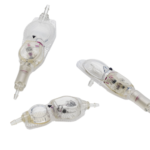Study Finds CERTAS™ Plus Programmable Valve Safe from Everyday Magnets
For patients with hydrocephalus who have a shunt with a programmable valve, there is a concern that getting too close to magnets can sometimes affect the valve settings. However, a new study funded by Codman, a division of Integra Lifesciences, and conducted by Jacobs Institute Engineering Solutions, claims that the CERTAS™ Plus Programmable Valve resisted interference from common household magnets, even at close proximity.
The study tested the CERTAS™ Plus Valve with a phone case, purse clasp, Magformers toy, Magz toy, magnetic wand, kitchen timer, earphones, iPhone 5S, iPad, an iPad case, a Cochlear™ Nucleus® sound processor coil with a 2M Coil Magnet installed, and an Apple AirPod® charging case. According to their data, the CERTAS™ Plus Valve did not show setting changes with any of the objects tested.
There are limitations of the study. The study has not been published in a peer-reviewed scientific journal, therefore there has been no independent review of the study design or analysis. In addition, at this time the results have not been verified by an independent research lab. Finally, the study was funded by Codman, the manufacturer of the CERTAS valve systems.
The FDA Studies
Between January 1998 and October 2012, the FDA conducted an analysis about the possible interaction between programmable CSF shunt valves and external sources containing magnets such as cell phones, electronic tablet devices, cordless power drills, headphones and earbuds. In 2019, the FDA also conducted a study about the possible interaction between programmable CSF shunt valves and implanted hearing devices containing magnets, since these devices are in close proximity to one another (see the FDA’s letter to healthcare providers for details). This can include hearing aids and cochlear implants. In both studies, they found that patients implanted with magnetic externally programmable CSF shunt valves may have a risk of experiencing an unintended change in their valve setting when exposed to strong magnetic fields.
The Bottom Line
We recommend that you know what type of valve you have and what the manufacturer recommends. When in doubt, follow the FDA suggestion of keeping products that contain magnets two or more inches away from the location of magnetic externally programmable CSF shunt valves.
“Patients are advised to use the ear opposite the shunt for devices requiring listening, such as cell phones and earbuds,” the FDA said.
For more information about the CERTAS™ Plus Valve study, visit: https://www.certasplus.com/.
For specific questions about your particular shunt valve, please speak to your doctor or visit the product description page on the website of your shunt manufacturer. You may also contact them if you have further questions.

